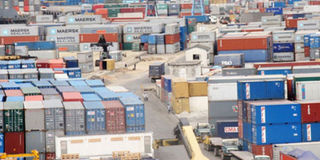New system slows cargo clearance at Mombasa port

Containers congested at Mombasa port. Port users are grappling with new technologies introduced to promote a seamless customs system in East Africa. FILE PHOTO
Kampala- Importers and exporters as well as those involved in the shipping and logistics are unhappy with the clearance system at the Mombasa port on grounds that it is slowing down business.
The industry players Daily Monitor spoke to yesterday say the Single Custom Territory (SCT) is doing more of a disservice to the business community than earlier anticipated.
However, Uganda Revenue Authority performance report indicates that there has been increased efficiency in revenue administration intervention, thanks to the automated customs valuation database and SCT.
The national chairman of the Uganda clearing and forwarding association, Mr Omar Kassim, said the snail-pace operations of the clearance automated systems at the Mombasa port is hurting business at the expense of revenue collection.
He said: “Each time there is a system upgrade, the business community suffers. We have been struggling with this problem for long. Generally, these systems are good for the regional governments because it helps them collect their due revenues but for the business community, it is slowing business.”
He added: “Clearing cargo now takes even a week. And that means we have extra days to pay for storage. So we are saying if that is the way to go then the charges we are incurring should be reduced.”
For Kampala City Traders Association secretary for mediation Lubega Mulondo, beside the slow clearance by the automated systems, there are also attitude issues of those manning the systems for they always seem unrepentant.
Daily Monitor sister company, the Business Daily, reported mid-week that Kenya Ports Authority (KPA) data shows that average time a container stays put at the Mombasa terminal is slightly more than five days compared to the previously three and half days.
KPA managing director Gichiri Ndua was quoted as saying the delay implies that cargo remained at the container terminal for an additional 1.6 days this year as users familiarised themselves with the new system.
“This performance was caused by teething problems following introduction of the Single Customs Territory (SCT),” Mr Ndua told an annual stakeholders’ meeting in Nairobi.
Among the new technologies, the East Africa Community partner states adopted the SCT system starting April 15, 2014, which allows for joint collection of customs taxes.
Under the SCT deal, clearing agents within the EAC have been granted rights to relocate and carry out their duties in any of the partner states as part of a strategy to improve the flow of goods and curb dumping.
Importers of commodities covered under the SCT are required to lodge import declaration forms in their home country and pay relevant taxes to facilitate the export process.
The tax authorities in the respective countries then issue a road manifest against the import documents submitted electronically by the revenue authority of the importing country.
Uganda’s traffic
Uganda continues to maintain a dominant position as the leading transit cargo destination, accounting for nearly 77 per cent share of the total transit traffic, according to Kenya Ports Authority statistics.
Overall growth for Uganda traffic increased from 4.9million tonnes in 2013 to 5.5million tonnes in 2014.
In 2014, Mombasa port handled a total of one million containers against 894,000 handled in 2013, registering an increase of 118,000 or 13 per cent transit traffic.
This was as a result of handling Ugandan cargo which increased by 609,000 or by 12 per cent.




